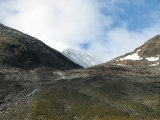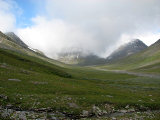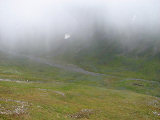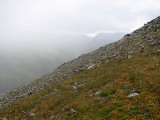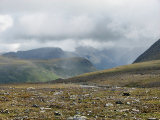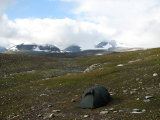Thursday 11/8
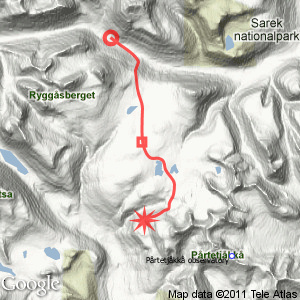
Luohttotjåhkkå – Loametjåhkkå
| Horizontal distance: | 14 km |
| Vertical distance: | -40 m, +500 m, -80 m, +120 m, -100 m |
| Time: | 5 h 30 min |
| Lunch break: | 30 min |
| Dinner: | Couscous with mushroom soup |
| Night accommodation: | Tent |
| Stage classification: | Medium |
There was both wind and rain in varying quantities throughout the night, and the early morning was fairly cold. Peeking out at 05:30 I saw very little due to low clouds, so I just remained in bed, expecting to spend at least part of the day in the tent – which I would have the time to do. However, when I arose over an hour later the clouds had lifted quite noticeably, the rain was no more, and there was even a bit of sunlight here and there, even though Luohttoláhko, where I intended to go, was still shrouded in fog. Now that the higher reaches of the nearby fjelds were visible, they bore witness of the chilly night in the form of fresh snow quite far down the slopes. After a bout of sleet the clouds started to break apart, and the sun came out as I had breakfast inside. Peaks to the east were also emerging in intervals, and things were really looking up, so I decided to break camp as usual and set out as planned.
I left after 09:45, wearing the rain clothes since there was still a bit of light rain in the air. Almost immediately I came to another arm of the glacier stream, but it was completely dry, so no worries – and the water level in the main course was appreciably lower than the day before. The ground, while mostly grassy, was wet at places, and I passed over many small "walls" of debris from old slides. I also passed a large mass of fresh excrement, but I could not determine whether or not a bear was responsible. It was a distinct possibility, though.
I passed above some areas of low osier thickets, which resulted in a slowly ascending course. Just after realizing that the dark-grey shape I had been looking at further ahead was in fact a domed tent I started going more decisively upwards, passing a rocky stream while the mists all around shifted. The slope I was now on consisted of nice grass criss-crossed by small furrows which I assumed had been made by lemmings under the snow, since they lead between holes in the ground. Climbing was not at all difficult, but somewhat exhausting due to the slant. Below me I spotted someone outside the tent, and above there were some resting reindeer with new calves, which got up and rounded me as I passed. A cloud was passing by almost below me, and looking up the valley I saw nothing but whiteness.
When I had almost reached the crest this whiteness arrived in the form of fairly dense snowfall, and I stood in the protection of a low cliff face while waiting for it to pass. Having come up onto Luohttoláhko I aimed for the low saddle in the direction of Bálgatjávrásj, walking first on flat rocks, and then mostly grass. The wind was now lessened, and further off to the south/southeast it looked almost clear; closer by the eastern clouds were lighter, but not the western ones. I passed the stream from Luohttojávrre with ease, and then ended up in an area of wet moss followed by stony dirt. The stones increased in number as the ground started slanting upwards, and down in the valleys the whiteness was impenetrable. The wind was now back to strong, and I searched around for a larger rock to sit down by, but only found a low one at 12:15.
I was now high enough to see the eastern peaks clearly again – or would have seen them, had the clouds been higher. I used the rucksack to better shield myself from the wind, and when the sun was out it was rather warm. But then came another bout of snow, and rather than dissipating it increased in intensity, so I huddled down and waited. When it finally passed I got moving again, wearing gloves against the cold wind. Behind me there was still a wall of white, but in front it was slowly getting lighter. The top of the rise was stony, and no real change was visible further ahead.
The sun came out again as I continued towards Bálgatjávrásj, going round the northern end, and some of the peaks were shedding their cloudy companions. I passed between Bálgatjávrásj and lake 1244 on stones, and then carefully plotted my continued route; I needed to get up onto the shelf at about 1350m on Loametjåhkkå from the northeast, since the ravine of Bálgatjåhkå is too steep below it. The various arms making up the beginning of this stream were fairly easily crossed, and then I rounded the rocky hill just north of the southern of the two glacier streams. That I could pass without difficulty a short distance downstream, where it spread out on rocks, and then I went straight up towards the shelf.
The ground was better here, but soon more snow came to ruin the mood, as it were. It was denser than before, and visibility was rather bad for a while. I followed fairly close to the edge, but then had to gain some altitude lest I end up in parts too steep. Here I walked almost exclusively on larger stones, and with the fresh wetness I treaded carefully. Finally the snow passed, and after some more rocks I could start to descend on nice grass. Some parts of Njoatsosvágge were showing, but mostly the clouds held sway. I rounded the slope aiming for the larger of the two tarns on this lower shelf – a well-utilized route to or from Luohttoláhko – and started looking for campsites. I passed a few patches that I thought could work, and after coming up empty closer to the water I returned to the first one around 15:15; I had not looked at the watch for some time, but it felt like I had been walking longer than that.
I set about pitching the tent, and in the middle of it two people walked by from the opposite direction. There was still a bit of wind, but it appeared as though this spot was at least partially sheltered, which would be a nice change. The weather was also improving, and I spent some time outside, going down to the tarn to have a quick wash; walking had been warm at times in the rain clothes, so it felt good. Just after I had moved in another bout of snow came, and it soon turned into sleet that obscured all views. I rested for a bit and almost dozed off, and then made dinner inside.
Now the sun was returning, and I went back out to enjoy it while it lasted. I climbed the hill at the foot of which I was camped, from where I had a great view of the surroundings; the clouds appeared to be lifting all around, but they still clung closely to the peaks. Looking across the tarn I spotted something which looked like a campsite with a low stone wall at the outflow of the little stream that joins Bálgatjåhkå – this would in all likelihood be a better spot than the hard, slanting one I had opted for, but I sure wasn't about to move the tent now. What had me a wee bit worried, though, was the thinness of the ground layer of my patch – in the event of prolonged rain I could very well imagine that a new brook could form under my tent. I therefore started building a low protective wall of flat rocks around the tent; I don't know how much good it would have done in case of an actual downpour, but it was not like I had any more pressing tasks to attend to.
Back inside I relaxed and read in my book, keeping the tent well ventilated to cope with the direct sunlight. Later in the evening the sky grew almost completely clear, but the clouds refused to let go of the peaks; in fact, they seemed to call in reinforcements in that department. The air was getting colder fast, and to get my temperature up after my evening snack I went back up the hill and looked out over the quiet land. Just then the full moon was rising, and the whole scene was very serene, especially since the wind had subsided. It was cold, though: the drops still present on the tent had frozen, and the thermometer on my watch showed an internal temperature of 3.6°C. I therefore put on thermal underwear before crawling into the sleeping bag around 22:15, preparing for an even colder night.






